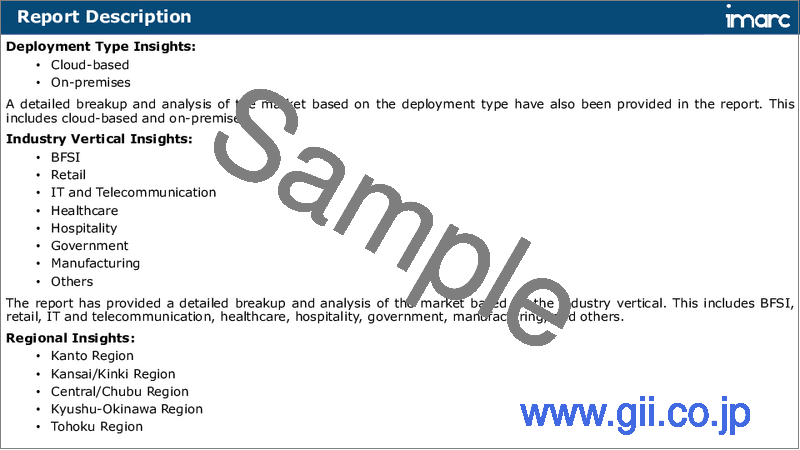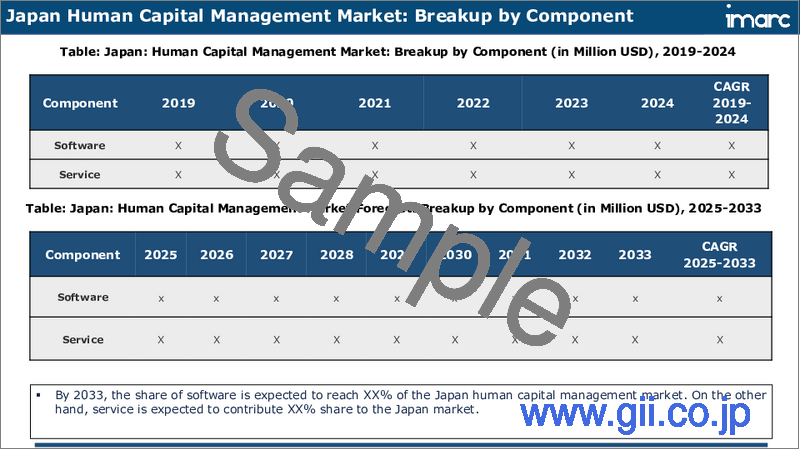|
|
市場調査レポート
商品コード
1746958
日本の人的資本管理市場の分析:コンポーネント別、展開方式別、業種別、地域別(2025~2033年)Japan Human Capital Management Market Report by Component, Deployment Type, Industry Vertical, and Region 2025-2033 |
||||||
カスタマイズ可能
|
|||||||
| 日本の人的資本管理市場の分析:コンポーネント別、展開方式別、業種別、地域別(2025~2033年) |
|
出版日: 2025年06月02日
発行: IMARC
ページ情報: 英文 119 Pages
納期: 5~7営業日
|
全表示
- 概要
- 目次
日本の人的資本管理(ヒューマンキャピタルマネジメント)の市場規模は2024年に15億6,720万米ドルに達しました。今後、IMARC Groupは、同市場が2033年までに28億8,320万米ドルに達し、2025年から2033年にかけて7.01%の成長率(CAGR)を示すと予測しています。戦略的な人事決定を行うためのデータ分析への企業の依存度の高まり、女性、外国人、世代間の雇用市場への参入者数の増加、リモートワークやハイブリッドワークモデルの広範な採用は、市場を牽引する主な要因の一部です。
当レポートで扱う主な質問
- 日本の人的資本管理市場はこれまでどのように推移し、今後どのように推移していくのか?
- COVID-19が日本人的資本管理市場に与えた影響は?
- 日本の人的資本管理市場のコンポーネント別の内訳は?
- 日本の人的資本管理市場の展開方式別の内訳は?
- 日本の人的資本管理市場の業種別の内訳は?
- 日本の人的資本管理市場のバリューチェーンにおける様々なステージとは?
- 日本の人的資本管理の主要な促進要因と課題は何か?
- 日本の人的資本管理市場の構造と主要企業は?
- 日本の人的資本管理市場における競合の程度は?
目次
第1章 序文
第2章 分析範囲・手法
- 分析目的
- ステークホルダー
- データソース
- 市場推定
- 分析手法
第3章 エグゼクティブサマリー
第4章 日本の人的資本管理市場:概要
- 概要
- 市場力学
- 業界動向
- 競合情報
第5章 日本の人的資本管理市場の情勢
- 過去・現在の市場動向(2019~2024年)
- 市場予測(2025~2033年)
第6章 日本の人的資本管理市場:コンポーネント別の内訳
- ソフトウェア
- サービス
第7章 日本の人的資本管理市場:展開方式別の内訳
- クラウドベース
- オンプレミス
第8章 日本の人的資本管理市場:業種別の内訳
- BFSI
- 小売り
- IT・通信
- ヘルスケア
- ホスピタリティ
- 政府
- 製造
- その他
第9章 日本の人的資本管理市場:競合情勢
- 概要
- 市場構造
- 市場企業のポジショニング
- 主要な成功戦略
- 競合ダッシュボード
- 企業評価象限
第10章 主要企業のプロファイル
第11章 日本の人的資本管理市場:業界分析
- 促進要因・抑制要因・機会
- ポーターのファイブフォース分析
- バリューチェーン分析
第12章 付録
Japan human capital management market size reached USD 1,567.2 Million in 2024. Looking forward, IMARC Group expects the market to reach USD 2,883.2 Million by 2033, exhibiting a growth rate (CAGR) of 7.01% during 2025-2033. The increasing reliance of businesses on data analytics to make strategic HR decisions, rising number of women, foreign nationals, and generations entering the job market, and widespread adoption of remote and hybrid work models represent some of the key factors driving the market.
Human capital management (HCM) refers to the strategic approach that organizations take to manage and optimize their workforce. It involves the acquisition, development, and management of people to achieve organizational goals effectively. It encompasses various human resource (HR) functions, including recruitment, training, performance management, and employee engagement. It can lead to higher employee productivity and performance. It helps in retaining talented individuals by providing growth opportunities and recognition. It reduces the need for manual data entry and paperwork, allowing HR professionals to focus on strategic initiatives. It incorporates robust security measures to safeguard data against breaches and unauthorized access, ensuring compliance with data protection regulations. It aids in identifying and recruiting the right talent, followed by effective onboarding processes. It supports employee skill development through training and continuous learning initiatives. It can accommodate multiple languages, currencies, and legal requirements, making it easier to standardize HR processes across borders. Besides this, as it enhances employee morale, job satisfaction, and overall engagement, the demand for HCM is increasing in Japan.
Japan Human Capital Management Market Trends:
The increasing reliance of businesses on data analytics to make strategic HR decisions represents one of the key factors favoring the market growth in Japan. Additionally, the widespread adoption of remote and hybrid work models in Japan is strengthening the growth of the market. HCM platforms are offering advanced analytics and reporting tools to help organizations gain insights into workforce performance, turnover rates, and employee engagement. Along with this, the increasing aging population and the shrinking workforce in the country are offering a favorable market outlook. HCM systems are helping organizations address these challenges by optimizing workforce planning, upskilling existing employees, and improving talent retention strategies. Apart from this, businesses in Japan are seeking HCM solutions that can be customized to their specific needs and integrated with other HR and enterprise resource planning (ERP) systems seamlessly, which is encouraging vendors to offer flexible, modular HCM platforms. Furthermore, several companies are increasingly focusing on environmental, social and governance (ESG) initiatives, including diversity and inclusion efforts, which is offering a favorable market outlook in the country. HCM systems are widely utilized to track and report on ESG metrics, aligning HR practices with broader sustainability goals. Moreover, rapid digital transformation across different industry verticals is propelling the market growth in Japan. HCM software and solutions aid in helping companies adapt to this digital shift by streamlining HR processes, automating administrative tasks, and improving data analytics for informed decision-making. Besides this, the increasing number of women, foreign nationals, and generations entering the job market is influencing the market positively. HCM solutions are helping organizations effectively manage this diversity by offering tools for inclusive recruitment, talent development, and cultural integration in Japan.
Japan Human Capital Management Market Segmentation:
Component Insights:
- Software
- Core HR
- Recruiting
- Workforce Management
- Compensation and Payroll
- Others
- Service
- Managed Service
- Professional
Deployment Type Insights:
- Cloud-based
- On-premises
Industry Vertical Insights:
- BFSI
- Retail
- IT and Telecommunication
- Healthcare
- Hospitality
- Government
- Manufacturing
- Others
Competitive Landscape:
The market research report has also provided a comprehensive analysis of the competitive landscape. Competitive analysis such as market structure, key player positioning, top winning strategies, competitive dashboard, and company evaluation quadrant has been covered in the report. Also, detailed profiles of all major companies have been provided.
Key Questions Answered in This Report:
- How has the Japan human capital management market performed so far and how will it perform in the coming years?
- What has been the impact of COVID-19 on the Japan human capital management market?
- What is the breakup of the Japan human capital management market on the basis of component?
- What is the breakup of the Japan human capital management market on the basis of deployment type?
- What is the breakup of the Japan human capital management market on the basis of industry vertical?
- What are the various stages in the value chain of the Japan human capital management market?
- What are the key driving factors and challenges in the Japan human capital management?
- What is the structure of the Japan human capital management market and who are the key players?
- What is the degree of competition in the Japan human capital management market?
Table of Contents
1 Preface
2 Scope and Methodology
- 2.1 Objectives of the Study
- 2.2 Stakeholders
- 2.3 Data Sources
- 2.3.1 Primary Sources
- 2.3.2 Secondary Sources
- 2.4 Market Estimation
- 2.4.1 Bottom-Up Approach
- 2.4.2 Top-Down Approach
- 2.5 Forecasting Methodology
3 Executive Summary
4 Japan Human Capital Management Market - Introduction
- 4.1 Overview
- 4.2 Market Dynamics
- 4.3 Industry Trends
- 4.4 Competitive Intelligence
5 Japan Human Capital Management Market Landscape
- 5.1 Historical and Current Market Trends (2019-2024)
- 5.2 Market Forecast (2025-2033)
6 Japan Human Capital Management Market - Breakup by Component
- 6.1 Software
- 6.1.1 Overview
- 6.1.2 Historical and Current Market Trends (2019-2024)
- 6.1.3 Market Segmentation
- 6.1.3.1 Core HR
- 6.1.3.2 Recruiting
- 6.1.3.3 Workforce Management
- 6.1.3.4 Compensation and Payroll
- 6.1.3.5 Others
- 6.1.4 Market Forecast (2025-2033)
- 6.2 Service
- 6.2.1 Overview
- 6.2.2 Historical and Current Market Trends (2019-2024)
- 6.2.2 Market Segmentation
- 6.2.3.1 Managed Service
- 6.2.3.2 Professional
- 6.2.4 Market Forecast (2025-2033)
7 Japan Human Capital Management Market - Breakup by Deployment Type
- 7.1 Cloud-based
- 7.1.1 Overview
- 7.1.2 Historical and Current Market Trends (2019-2024)
- 7.1.3 Market Forecast (2025-2033)
- 7.2 On-premises
- 7.2.1 Overview
- 7.2.2 Historical and Current Market Trends (2019-2024)
- 7.2.3 Market Forecast (2025-2033)
8 Japan Human Capital Management Market - Breakup by Industry Vertical
- 8.1 BFSI
- 8.1.1 Overview
- 8.1.2 Historical and Current Market Trends (2019-2024)
- 8.1.3 Market Forecast (2025-2033)
- 8.2 Retail
- 8.2.1 Overview
- 8.2.2 Historical and Current Market Trends (2019-2024)
- 8.2.3 Market Forecast (2025-2033)
- 8.3 IT and Telecommunication
- 8.3.1 Overview
- 8.3.2 Historical and Current Market Trends (2019-2024)
- 8.3.3 Market Forecast (2025-2033)
- 8.4 Healthcare
- 8.4.1 Overview
- 8.4.2 Historical and Current Market Trends (2019-2024)
- 8.4.3 Market Forecast (2025-2033)
- 8.5 Hospitality
- 8.5.1 Overview
- 8.5.2 Historical and Current Market Trends (2019-2024)
- 8.5.3 Market Forecast (2025-2033)
- 8.6 Government
- 8.6.1 Overview
- 8.6.2 Historical and Current Market Trends (2019-2024)
- 8.6.3 Market Forecast (2025-2033)
- 8.7 Manufacturing
- 8.7.1 Overview
- 8.7.2 Historical and Current Market Trends (2019-2024)
- 8.7.3 Market Forecast (2025-2033)
- 8.8 Others
- 8.8.1 Historical and Current Market Trends (2019-2024)
- 8.8.2 Market Forecast (2025-2033)
9 Japan Human Capital Management Market - Competitive Landscape
- 9.1 Overview
- 9.2 Market Structure
- 9.3 Market Player Positioning
- 9.4 Top Winning Strategies
- 9.5 Competitive Dashboard
- 9.6 Company Evaluation Quadrant
10 Profiles of Key Players
- 10.1 Company A
- 10.1.1 Business Overview
- 10.1.2 Product Portfolio
- 10.1.3 Business Strategies
- 10.1.4 SWOT Analysis
- 10.1.5 Major News and Events
- 10.2 Company B
- 10.2.1 Business Overview
- 10.2.2 Product Portfolio
- 10.2.3 Business Strategies
- 10.2.4 SWOT Analysis
- 10.2.5 Major News and Events
- 10.3 Company C
- 10.3.1 Business Overview
- 10.3.2 Product Portfolio
- 10.3.3 Business Strategies
- 10.3.4 SWOT Analysis
- 10.3.5 Major News and Events
- 10.4 Company D
- 10.4.1 Business Overview
- 10.4.2 Product Portfolio
- 10.4.3 Business Strategies
- 10.4.4 SWOT Analysis
- 10.4.5 Major News and Events
- 10.5 Company E
- 10.5.1 Business Overview
- 10.5.2 Product Portfolio
- 10.5.3 Business Strategies
- 10.5.4 SWOT Analysis
- 10.5.5 Major News and Events
11 Japan Human Capital Management Market - Industry Analysis
- 11.1 Drivers, Restraints, and Opportunities
- 11.1.1 Overview
- 11.1.2 Drivers
- 11.1.3 Restraints
- 11.1.4 Opportunities
- 11.2 Porters Five Forces Analysis
- 11.2.1 Overview
- 11.2.2 Bargaining Power of Buyers
- 11.2.3 Bargaining Power of Suppliers
- 11.2.4 Degree of Competition
- 11.2.5 Threat of New Entrants
- 11.2.6 Threat of Substitutes
- 11.3 Value Chain Analysis





